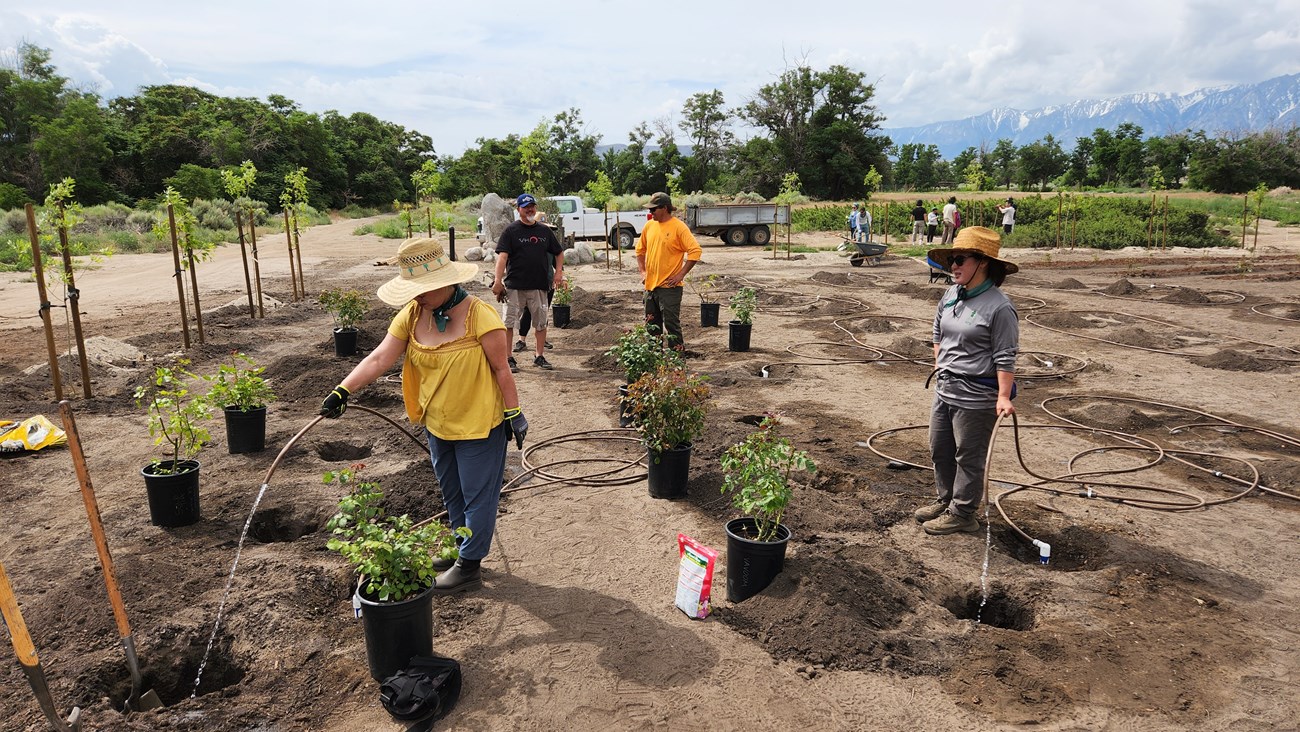Last updated: April 22, 2025
Article
Return of the Rose Garden to Manzanar

As one of 10 incarceration camps established by Executive Order in 1942, Manzanar War Relocation Camp was hastily built to detain 10,000 people of Japanese ancestry living on the US West Coast. Detainees were permitted to take into the camps only what they could carry. Harsh living conditions were exacerbated by wind-driven sand that whipped through the camp. One impetus for gardens began with sowing turfgrass to control dust. Almost immediately, though, the incarcerated people began sowing vegetables and flowers, and crafting garden features from woody debris. Within a few months, they had organized to develop gardens throughout the camp, ranging in size from a few square feet to 2.5 acres.
Located within a space left open as a firebreak, the “western style” Rose Garden was started by Kuichiro Nishi in the fall of 1942. Like many of the incarcerated people at Manzanar, Nishi had horticultural experience, as the Nishi family business included a nursery that specialized in roses. Nishi persuaded the camp director to allow him to propagate roses by grafting the buds of hybrid tea roses onto wild desert roses of the camp, that would serve as rootstock. His industry, along with incarcerated community members, led to the establishment of a rose garden of approximately 50 varieties.

Nishi worked with Takio Muto and other incarcerated gardeners to design additions to the Rose Garden. Adjacent, they built a Japanese stroll garden with two large ponds, rock features, transplanted trees and ornamental plants. Named “Merritt Park” in honor of the camp director, the park was a much-photographed sanctuary where people could momentarily forget they were imprisoned. At the end of World War II, the incarcerated people were released and the camp was dismantled, leaving the gardens to become inundated by sand and colonizing vegetation.
Since the 1992 establishment of the park, archeological and historical research has revealed that dozens of gardens are still represented at Manzanar by rock and wood features, topography, and to some extent, by vegetation. The 2006 Cultural Landscape Report and the 2015 Garden Management Plan incorporated this research, and established an objective to restore Merritt Park and the Rose Garden. This objective had the support of the local and descendant communities, including Kuichiro Nishi’s son, Henry.
The relationships cultivated by the park with associated communities fueled efforts to restore the Rose Garden. Tia Morita, whose mother was born to her incarcerated grandparents in Manzanar, galvanized a cohort of volunteers to purchase roses, materials and lend their labor to the Rose Garden. The only constraints were that roses should be suitable for USDA zones 4-9 and hybrid teas. With the park’s support, Tia and her family donated varieties to commemorate family members. For a year and a half, Tia commuted three-hours every month from Los Angeles to work on site preparation, planting and care of the rose plants.

Begun in 2022, restoration efforts were on target for a rededication ceremony in October 2023. Plans were abruptly halted when Hurricane Hilary flooded the park in August 2023 and dumped silt and debris throughout the Rose Garden. The work turned to uncovering and removing some roses to allow heavy equipment to maneuver. Once again, Tia, the other volunteers and park staff pitched in, clearing and replanting where necessary to salvage the garden. By early 2024, more than 120 rose plants made up the Rose Garden, consisting of varieties that represent a few from the period of significance, but more that are newer hybrids.
Since World War II, the rose industry has developed hundreds of varieties that are more resilient to cold, drought and pests than their earlier counterparts. The new varieties are similar in form but hardier than the originals. Each selected variety has significance to community members. Many of the roses were purchased from Sego Nursery in the San Fernando Valley, owned and operated by the grandchildren of Seigoro Murakami, the Judo master at Manzanar.

